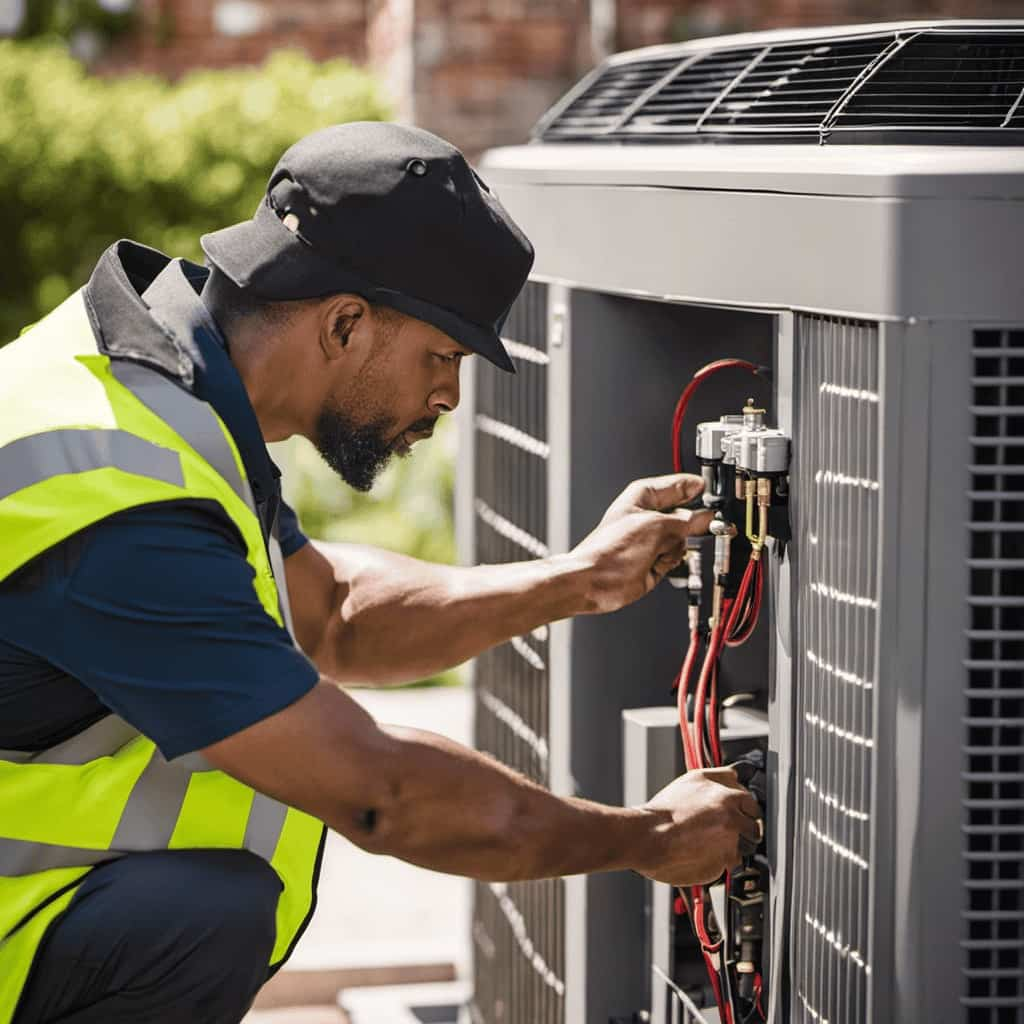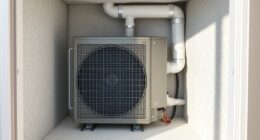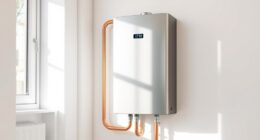We have exclusive details on various types of heat pumps!
Did you know that heat pumps can save up to 50% on energy costs compared to traditional heating systems?
In this article, we’ll break down different types of heat pumps and their energy efficiency ratings.
We’ll compare air source and ground source heat pumps, explore the benefits of geothermal heat pumps, decode hybrid and water source heat pumps, and analyze variable speed and dual fuel heat pumps.

Get ready to optimize your energy efficiency!
Key Takeaways
- Different types of heat pumps, such as air-source, ground-source, water-source, and geothermal, offer various benefits and energy efficiency levels.
- Energy efficiency ratings, measured by SEER and HSPF, determine the efficiency of heat pumps, with higher ratings indicating better efficiency.
- Climate, available space, and budget are important factors to consider when choosing between air source and ground source heat pumps.
- Hybrid heat pumps, ductless mini-split heat pumps, absorption heat pumps, water source heat pumps, variable speed heat pumps, and dual fuel heat pumps are other varieties that offer efficient heating and cooling options.
Types of Heat Pumps
Let’s delve into the different types of heat pumps to better understand their energy efficiency.
When it comes to types of heat pump installation, there are three main categories: air-source, ground-source, and water-source heat pumps.
Air-source heat pumps extract heat from the outside air and transfer it inside during the winter, and vice versa during the summer.

Ground-source heat pumps, also known as geothermal heat pumps, utilize the stable temperature of the ground to heat or cool a space.
Water-source heat pumps extract heat from a water source, such as a lake or a well.
Each type of heat pump installation has its own benefits.
Heat pump technology offers high energy efficiency, as it transfers heat instead of generating it, resulting in significant energy savings and reduced greenhouse gas emissions.
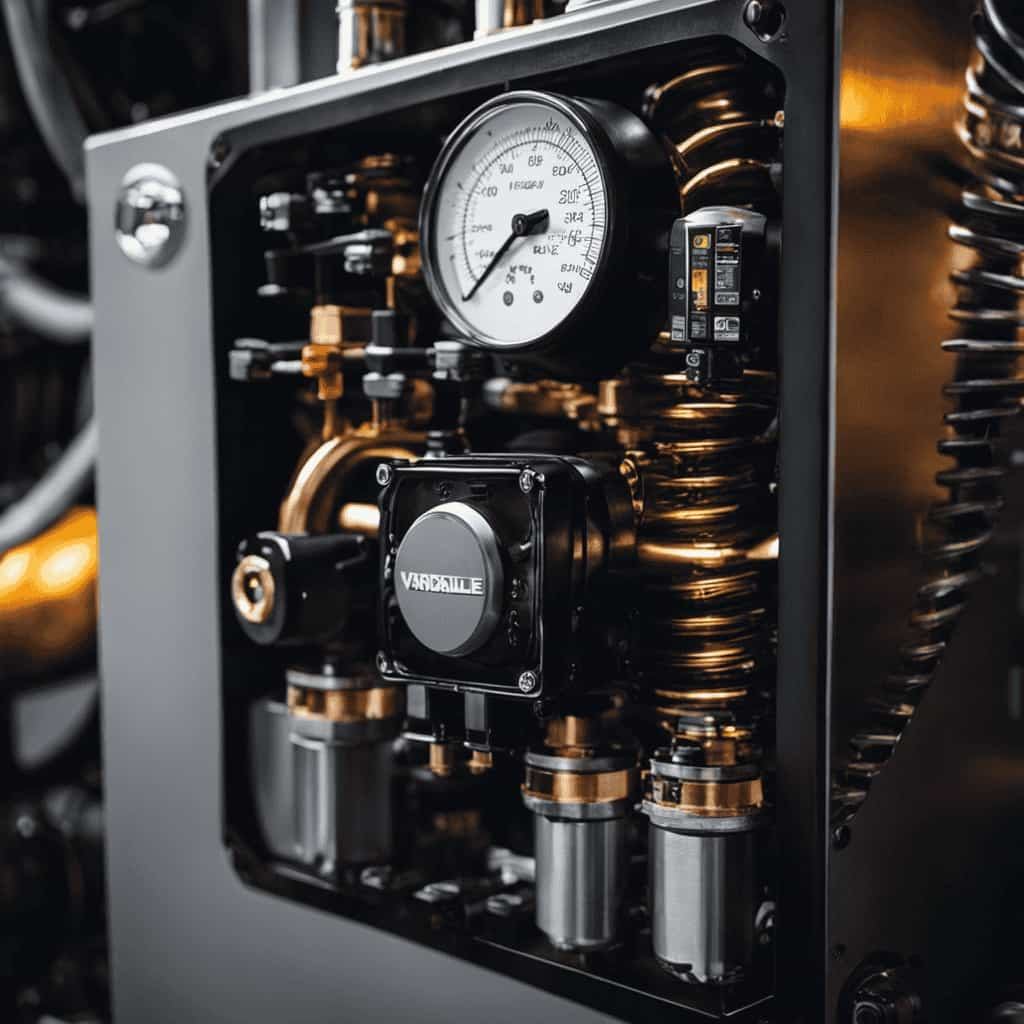
Understanding Energy Efficiency Ratings
When it comes to understanding energy efficiency ratings, we need to consider various factors that impact the overall performance of heat pumps. To help you navigate through the complexity of energy efficiency standards, here are some key points to keep in mind:
-
Energy Efficiency Standards: Energy efficiency ratings are determined by industry standards that measure the efficiency of heat pumps in terms of cooling and heating output.
-
SEER (Seasonal Energy Efficiency Ratio): SEER ratings indicate the efficiency of a heat pump’s cooling performance over a typical cooling season.
-
HSPF (Heating Seasonal Performance Factor): HSPF ratings measure the efficiency of a heat pump’s heating performance over a typical heating season.

-
Higher is Better: When it comes to energy efficiency ratings, a higher SEER or HSPF rating signifies a more efficient heat pump.
-
Consider Climate: It’s important to select a heat pump with energy efficiency ratings that are suitable for your specific climate.
Understanding these energy efficiency ratings will set the foundation for comparing air source and ground source heat pumps in the next section.
Comparing Air Source and Ground Source Heat Pumps
To make an informed decision about heat pump options, we must compare the efficiency and effectiveness of air source and ground source heat pumps. Both types of pumps are designed to provide heating and cooling for residential and commercial spaces, but they have significant differences in how they extract and utilize heat.

| Heat Pump Type | Energy Efficiency |
|---|---|
| Air Source | Moderate to High |
| Ground Source | High |
Air source heat pumps extract heat from the outside air, while ground source heat pumps, also known as geothermal heat pumps, extract heat from the ground. Ground source heat pumps are generally more energy efficient, with higher coefficient of performance (COP) values, compared to air source heat pumps. This is because the ground temperature remains relatively stable throughout the year, providing a consistent heat source for the pump. On the other hand, air source heat pumps are easier and cheaper to install, making them a more affordable option for some homeowners. Ultimately, the choice between an air source and ground source heat pump depends on factors such as climate, available space, and budget.
Exploring the Benefits of Geothermal Heat Pumps
Why are geothermal heat pumps considered a beneficial option for maximizing energy efficiency?
Geothermal heat pumps offer several advantages that make them an attractive choice for homeowners and businesses alike. Consider the following benefits:
-
Significant energy savings: Geothermal heat pumps can reduce energy consumption by up to 70% compared to traditional heating and cooling systems.

-
Long-term cost savings: While the upfront cost of geothermal heat pump installation may be higher, the long-term energy savings can outweigh the initial investment.
-
Environmental friendliness: Geothermal heat pumps use renewable energy from the ground, resulting in lower greenhouse gas emissions and a smaller carbon footprint.
-
Consistent performance: Geothermal systems provide consistent heating and cooling throughout the year, regardless of the outdoor temperature.
-
Durability and reliability: Geothermal heat pumps have fewer mechanical components, resulting in reduced maintenance needs and a longer lifespan.

With these benefits, geothermal heat pumps offer a sustainable and efficient solution for heating and cooling needs while reducing energy costs and environmental impact.
Decoding Hybrid Heat Pumps
Our experience has shown that combining the best features of traditional and electric heat pumps, hybrid heat pumps offer a versatile and energy-efficient solution for heating and cooling.
Hybrid heat pump technology utilizes both electric and fossil fuel sources to maximize energy efficiency. By integrating the electric heat pump with a traditional furnace or boiler, the hybrid heat pump takes advantage of the strengths of each system.
In colder weather, the hybrid heat pump automatically switches to the fossil fuel source, which is more efficient at lower temperatures. This allows for efficient heating even in extreme temperatures. In milder conditions, the electric heat pump takes over, providing a more energy-efficient solution.

The hybrid heat pump advantages include increased energy savings, reduced carbon emissions, and improved comfort and reliability. With hybrid heat pumps, homeowners can enjoy the benefits of both electric and traditional heat pump systems, optimizing energy efficiency and comfort.
Evaluating Ductless Mini-Split Heat Pumps
When evaluating ductless mini-split heat pumps, there are several energy-saving benefits to consider. These heat pumps offer efficient heating and cooling capabilities, resulting in reduced energy consumption and lower utility bills.
Additionally, their installation flexibility allows for easy placement in various areas of a home or building, ensuring optimal comfort and efficiency.
Energy-Saving Benefits Explained
-
We have evaluated the energy-saving benefits of ductless mini-split heat pumps. These innovative systems offer several advantages that can significantly improve energy efficiency in your home.

-
Enhanced Energy Efficiency: Ductless mini-split heat pumps have high energy efficiency ratings, allowing you to save on your utility bills while reducing your carbon footprint.
-
Zoned Heating and Cooling: With individual indoor units, you can customize the temperature in different areas of your home, avoiding wasted energy in unoccupied rooms.
-
No Ductwork Losses: By eliminating the need for ductwork, ductless mini-split heat pumps eliminate the energy losses often associated with traditional HVAC systems.
-
Heat and Cool Simultaneously: Some models feature the ability to heat and cool different zones simultaneously, maximizing comfort and energy savings.

-
Advanced Inverter Technology: Ductless mini-split heat pumps utilize inverter technology to precisely control the compressor speed, resulting in optimal energy usage.
Understanding these energy-saving benefits will help you make an informed decision when considering a ductless mini-split heat pump for your home.
Now, let’s explore the installation flexibility advantages of these systems.
Installation Flexibility Advantages
Installing ductless mini-split heat pumps offers numerous advantages in terms of flexibility and adaptability, making them an ideal choice for a variety of home configurations. These heat pumps utilize innovative installation techniques that allow for easy integration into existing spaces without the need for extensive ductwork. This not only reduces installation time and costs but also minimizes disruption to the home during the installation process. Additionally, ductless mini-split heat pumps provide exceptional energy savings potential due to their ability to deliver heating and cooling directly to specific zones within the home. This targeted approach ensures optimal comfort and efficiency, as energy is not wasted on conditioning unoccupied areas. With their installation flexibility and energy-saving capabilities, ductless mini-split heat pumps offer a cost-effective heating alternative that can benefit homeowners in various ways.

| Advantages of Ductless Mini-Split Heat Pumps | ||
|---|---|---|
| Flexibility | Adaptability | Energy Efficiency |
| Easy integration into existing spaces | Deliver heating and cooling directly to specific zones | Minimize energy wastage |
| Reduced installation time and costs | Targeted approach for optimal comfort and efficiency | Cost-effective heating alternative |
| Minimal disruption during installation | Ideal choice for a variety of home configurations | Significant energy savings potential |
In the next section, we will explore the cost-effective heating alternative provided by ductless mini-split heat pumps.
Cost-Effective Heating Alternative
Our evaluation of ductless mini-split heat pumps reveals their potential as a cost-effective heating alternative. These innovative systems offer numerous benefits, making them an attractive choice for homeowners seeking energy-efficient solutions.
Here are five key reasons why ductless mini-split heat pumps are worth considering:
-
Easy Installation: Ductless mini-split heat pumps require minimal installation effort, eliminating the need for extensive ductwork and reducing labor costs.

-
Zone Heating: With the ability to heat individual rooms or zones, ductless mini-split heat pumps allow for precise temperature control, resulting in energy savings.
-
Energy Efficiency: These systems use advanced technology to maximize energy efficiency, reducing heating costs and environmental impact.
-
Flexibility: Ductless mini-split heat pumps can be installed in various locations, making them suitable for both new construction and retrofit projects.
-
Enhanced Comfort: By providing both heating and cooling capabilities, ductless mini-split heat pumps ensure year-round comfort for occupants.

To optimize cost savings and energy efficiency, consider these cost-effective installation methods and energy-saving tips when utilizing ductless mini-split heat pumps.
Unraveling the Mysteries of Absorption Heat Pumps
Understanding the inner workings of absorption heat pumps can be a complex task, but it’s crucial for maximizing energy efficiency.
Absorption heat pumps are a type of heat pump that relies on a different principle than traditional vapor-compression heat pumps. They’re primarily used in applications where waste heat or low-grade heat sources are available, such as industrial processes, cogeneration systems, and solar heating.
One of the key advantages of absorption heat pumps is their ability to operate on low-grade heat sources, which makes them highly efficient and cost-effective. They also have fewer moving parts compared to vapor-compression heat pumps, resulting in reduced maintenance and longer lifespan.

Investigating Water Source Heat Pumps
Water source heat pumps are an interesting variety to explore when it comes to optimizing energy efficiency. One point of consideration is the efficiency of water source heat pumps compared to other types.
Additionally, it’s important to assess the cost of implementing water source heat pumps and how they compare to other options.
Lastly, an environmental impact assessment should be conducted to determine the sustainability of water source heat pumps in various settings.
Efficiency of Water Source
We can evaluate the efficiency of water source heat pumps by examining their performance in transferring heat from a water source to the building. When considering the efficiency of water source heat pumps, there are several important factors to consider:

-
Cost Analysis: It’s crucial to assess the initial cost of installing a water source heat pump system and compare it to the potential long-term energy savings. Conducting a thorough cost analysis will help determine the overall efficiency of the system.
-
Thermal Conductivity: The thermal conductivity of the water source plays a significant role in the heat transfer process. Higher thermal conductivity allows for more efficient heat exchange, resulting in improved energy efficiency.
-
Water Quality: The quality of the water source can impact the performance of the heat pump. Contaminants or impurities in the water can reduce the efficiency of the heat transfer process and require additional maintenance.
-
System Design: The design of the water source heat pump system, including the size and layout of the heat exchanger, can greatly affect its efficiency. Proper system design ensures optimal heat transfer and energy efficiency.
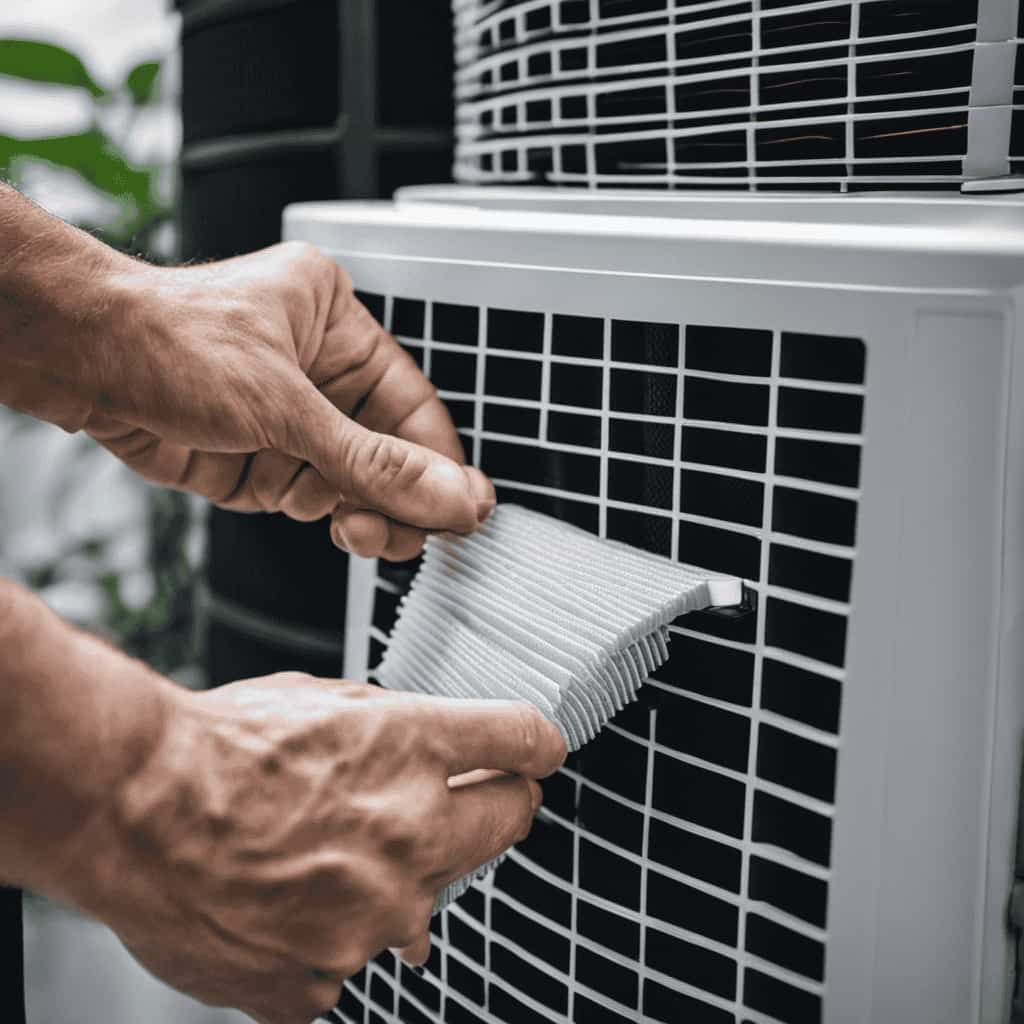
-
Maintenance and Operation: Regular maintenance and proper operation of the water source heat pump system are essential for maintaining its efficiency. Regular inspections, filter cleaning, and correct thermostat settings all contribute to the overall efficiency of the system.
Cost Comparison With Others
To compare the cost of water source heat pumps with other options, we need to consider various factors such as installation expenses and potential long-term energy savings.
Water source heat pumps are known for their energy-saving benefits, as they utilize the consistent temperature of groundwater or surface water to efficiently heat or cool a building.
When comparing costs, it’s important to evaluate the initial investment, including the price of the equipment, installation, and any necessary modifications to the water source.

While water source heat pumps may have higher upfront costs compared to other heating and cooling systems, their energy efficiency can result in significant savings over time.
Additionally, the long lifespan of these systems contributes to their overall cost-effectiveness.
Considering both the initial expenses and the potential energy savings, water source heat pumps can prove to be a financially viable option for many buildings.
Now, let’s move on to the next section and assess the environmental impact of these heat pump varieties.

Environmental Impact Assessment?
An assessment of the environmental impact of water source heat pumps reveals their potential for energy efficiency and sustainability. These systems utilize renewable energy sources, such as groundwater or nearby bodies of water, to provide heating and cooling for buildings.
Here are some key points to consider when conducting an environmental impact assessment of water source heat pumps:
-
Energy Consumption Estimation: Measure the energy consumed by the heat pump system to determine its environmental impact.
-
Water Usage: Assess the water requirements of the heat pump and evaluate the sustainability of the water source.

-
Noise Pollution: Analyze the noise levels generated by the heat pump system and its potential impact on the surrounding environment.
-
Emissions: Evaluate the emissions produced by the heat pump, including greenhouse gases and other pollutants.
-
Life Cycle Assessment: Consider the environmental impact of the entire life cycle of the heat pump, including manufacturing, installation, operation, and disposal.
Analyzing Variable Speed Heat Pumps
Analyzing the performance of variable speed heat pumps can lead to improved energy efficiency. Variable speed technology allows heat pumps to operate at different speeds, adjusting their output to meet the specific heating or cooling needs of a space. By continuously varying the speed of the compressor and fan, these heat pumps can provide precise temperature control while consuming less energy compared to traditional fixed-speed models.

To better understand the energy-saving potential of variable speed heat pumps, an energy consumption analysis can be conducted. This analysis involves monitoring and recording the energy usage of the heat pump over a specific period of time, while also taking into account factors such as outdoor temperature, indoor temperature settings, and occupancy patterns. By comparing the energy consumption of the variable speed heat pump with that of a fixed-speed model, it becomes possible to quantify the energy savings and determine the payback period for the investment in a variable speed heat pump.
To illustrate the potential energy savings, consider the following table:
| Heat Pump Model | Energy Consumption (kWh) |
|---|---|
| Fixed-Speed Heat Pump | 1000 |
| Variable Speed Heat Pump | 800 |
As shown in the table, the variable speed heat pump consumed 200 kWh less energy compared to the fixed-speed model. This translates to a significant reduction in energy costs and a shorter payback period for the investment in the variable speed heat pump.
Analyzing variable speed heat pumps through energy consumption analysis can provide valuable insights into their energy-saving potential. By choosing a heat pump with variable speed technology, homeowners can not only enjoy improved comfort but also contribute to a more sustainable and energy-efficient future.

Optimizing Energy Efficiency With Dual Fuel Heat Pumps
By utilizing both electric heat pumps and a secondary fuel source, we can maximize energy efficiency and reduce reliance on a single fuel type. Dual fuel heat pumps offer several benefits for optimizing energy usage:
-
Increased efficiency: Dual fuel heat pumps combine the efficiency of electric heat pumps with the higher heating capacity of a secondary fuel source, such as natural gas or propane.
-
Cost savings: By using the most cost-effective fuel source at any given time, dual fuel heat pumps help minimize energy expenses.
-
Flexibility: Dual fuel heat pumps offer the flexibility to switch between electric and the secondary fuel source based on availability and pricing.

-
Environmental friendliness: Opting for electric heat pumps when electricity is generated from renewable sources can lead to reduced carbon emissions and a greener footprint.
-
Reliability: The availability of a secondary fuel source ensures uninterrupted heating and cooling even during power outages.
Transition: Now that we’ve explored the benefits of dual fuel heat pumps, let’s delve into the factors that affect the energy efficiency of heat pumps in general.
Factors Affecting the Energy Efficiency of Heat Pumps
When it comes to the energy efficiency of heat pumps, there are several factors that play a crucial role.

Climate and location are key considerations, as they affect the heat pump’s performance and how often it needs to run.
Additionally, proper insulation and regular maintenance are vital for optimizing energy efficiency, as they prevent heat loss and ensure the system operates at its best.
Climate and Location
We should take into account the climate and location when considering the energy efficiency of heat pumps. The following geographical considerations are crucial in optimizing their performance:
- Climate change: The increasing temperatures and changing weather patterns necessitate heat pumps that can adapt to varying conditions.
- Temperature extremes: Extreme cold or hot climates require heat pumps with higher capacity and efficiency to provide the desired indoor comfort.
- Humidity levels: Areas with high humidity levels may benefit from heat pumps with enhanced dehumidification capabilities.
- Elevation: Higher altitudes can affect the efficiency of heat pumps due to lower air density and reduced heat transfer.
- Regional energy sources: The availability of renewable energy sources in a specific area can impact the carbon footprint and overall energy efficiency of heat pumps.
Considering these factors ensures that heat pumps are selected and installed to maximize their energy efficiency in different climates and locations.

Now, let’s move on to the next section, which discusses the importance of insulation and maintenance in optimizing the performance of heat pumps.
Insulation and Maintenance
Regular insulation and maintenance is essential for maximizing the energy efficiency of heat pumps. Proper insulation helps to minimize heat loss and ensure that the heat pump operates at its highest efficiency. By reducing heat loss, insulation allows the heat pump to maintain a consistent temperature, which results in less energy consumption. Insulating the ductwork, walls, and pipes also prevents heat transfer and improves overall efficiency.
Additionally, regular maintenance is crucial for optimal performance. It’s recommended to clean the air filters regularly to ensure proper airflow and prevent dust buildup. Checking and cleaning the coils, fins, and condensate drains is also important to maintain the heat pump’s efficiency.
Frequently Asked Questions
What Is the Average Lifespan of a Heat Pump?
The average lifespan of a heat pump depends on various factors such as regular heat pump maintenance and recognizing signs of heat pump failure. It is important to stay informed and proactive in order to maximize efficiency and longevity.

How Often Should a Heat Pump Be Serviced?
Regular heat pump maintenance is crucial for optimal performance and energy efficiency. We recommend scheduling professional servicing at least once a year to ensure proper operation, extend the lifespan, and prevent costly repairs.
Can a Heat Pump Be Used to Cool a Home in Addition to Heating It?
Yes, a heat pump can be used to cool a home in addition to heating it. Heat pump cooling efficiency is high, and the benefits of heat pump cooling include energy savings and year-round comfort.
Are There Any Tax Incentives or Rebates Available for Installing a Heat Pump?
Tax incentives and rebates are available for installing heat pumps, which can lead to significant energy savings. By taking advantage of these incentives, homeowners can reduce their costs while also improving their home’s energy efficiency.
Can a Heat Pump Be Used in Extremely Cold Climates?
Yes, a heat pump can be used in extremely cold climates, but it may face challenges in terms of heat pump efficiency and installation. However, with proper insulation and backup heat sources, it can still provide effective heating.

Conclusion
In conclusion, understanding the different varieties of heat pumps is crucial for achieving optimal energy efficiency.
From air source and ground source heat pumps to geothermal, hybrid, and water source heat pumps, each type offers its own set of benefits and considerations.
By analyzing factors such as energy efficiency ratings and variable speed capabilities, homeowners can make informed decisions to reduce energy consumption and save on utility costs.
With the right heat pump, the possibilities for energy savings are boundless.




